International Tourism: CRM Evaluation in Mandarin Oriental Hotels
VerifiedAdded on 2023/06/08
|22
|5826
|496
Report
AI Summary
This report critically evaluates the role of customer relationship management (CRM) within the Mandarin Oriental Hotel Group, analyzing literature and studies from 2001 to the present to understand current trends in hospitality. It explores the evolution of CRM, its components like customer prospecting and interactive management, and its impact on customer loyalty and business growth. The report also examines hospitality management's significance in tourism, emphasizing the importance of customer service and emotional bonding. By focusing on the Mandarin Oriental Hotel Group, the study aims to identify potential gaps in hospitality management systems and provide recommendations for enhancing customer relationships and overall service delivery, highlighting the integration of technology, strategic human resource management, and customer-centric approaches in the luxury hotel sector. Desklib provides access to similar reports and study resources for students.

international tourism and hospitality Management
Institutional Affiliation(s)
TOPIC
"Critical evaluation of the role of customer
relationship management in Mandarin Oriental Hotel
Group"
Student Name
[Course title]
Institutional Affiliation(s)
TOPIC
"Critical evaluation of the role of customer
relationship management in Mandarin Oriental Hotel
Group"
Student Name
[Course title]
Paraphrase This Document
Need a fresh take? Get an instant paraphrase of this document with our AI Paraphraser

P a g e | 1
Table of Contents
Introduction................................................................................................................................2
Literature Review.......................................................................................................................3
Literature Review on Customer Relationship Management..................................................3
Literature Review on Hospitality Management.....................................................................7
Case study................................................................................................................................11
Case study of Mandarin Oriental hotel Group.....................................................................11
Recommendations....................................................................................................................15
Conclusion................................................................................................................................16
References................................................................................................................................18
Table of Contents
Introduction................................................................................................................................2
Literature Review.......................................................................................................................3
Literature Review on Customer Relationship Management..................................................3
Literature Review on Hospitality Management.....................................................................7
Case study................................................................................................................................11
Case study of Mandarin Oriental hotel Group.....................................................................11
Recommendations....................................................................................................................15
Conclusion................................................................................................................................16
References................................................................................................................................18

P a g e | 2
Introduction
International hospitality management and luxury hotels has become an important
segment in general tourism and hospitality industry that is undergoing rapid expansions. In
February 2013, Forbes Travel Guide Star Awards awarded 226 four-star hotels and 76 five-
star hotels situated globally which showed an increase of 28.4% and 33% respectively.
Again, in September 2013 the same awards were distributed among 264 four-star hotels and
83 five-star hotels which showed an increase of 16% and 9% respectively and that to in a
same year. It must be noted that every week, more than one luxury hotel was built during the
aforesaid time period (Chu, 2014). Due to internationalisation and competitiveness, tourism
and international hospitality industry has also strengthened with time where well managed
companies are seen increasing in hotel and travel business. In fact, much of the existing
companies are getting enlarged by incorporating innovations to stay ahead of the game. There
are others who try and cut their expenses to save cash for providing enhanced customer
satisfaction within client’s budget. According to Singal & Rhou (2017), the effect of
hospitality management on people can be seen greatly in society at large. Although there are
few issues associated while dealing with customer relationship management, it can be taken
as a part of business. Contemporary hospitality organisations are governed by technology and
innovation along with strategic human resource management (SHRM) so that enhanced
service is provided to the customers while ensuring sustainability of business enterprise
(Ariffin, et al., 2011). There are few challenges also that comes in the path of hospitality
management like gathering of data to select preferred customers or dealing with diversified
culture clients. Nevertheless, hospitality businesses gather data after overcoming various
challenges so that they can serve their customers in a better way which is necessary for their
business. This report will critically evaluate present trends in hospitality and customer
Introduction
International hospitality management and luxury hotels has become an important
segment in general tourism and hospitality industry that is undergoing rapid expansions. In
February 2013, Forbes Travel Guide Star Awards awarded 226 four-star hotels and 76 five-
star hotels situated globally which showed an increase of 28.4% and 33% respectively.
Again, in September 2013 the same awards were distributed among 264 four-star hotels and
83 five-star hotels which showed an increase of 16% and 9% respectively and that to in a
same year. It must be noted that every week, more than one luxury hotel was built during the
aforesaid time period (Chu, 2014). Due to internationalisation and competitiveness, tourism
and international hospitality industry has also strengthened with time where well managed
companies are seen increasing in hotel and travel business. In fact, much of the existing
companies are getting enlarged by incorporating innovations to stay ahead of the game. There
are others who try and cut their expenses to save cash for providing enhanced customer
satisfaction within client’s budget. According to Singal & Rhou (2017), the effect of
hospitality management on people can be seen greatly in society at large. Although there are
few issues associated while dealing with customer relationship management, it can be taken
as a part of business. Contemporary hospitality organisations are governed by technology and
innovation along with strategic human resource management (SHRM) so that enhanced
service is provided to the customers while ensuring sustainability of business enterprise
(Ariffin, et al., 2011). There are few challenges also that comes in the path of hospitality
management like gathering of data to select preferred customers or dealing with diversified
culture clients. Nevertheless, hospitality businesses gather data after overcoming various
challenges so that they can serve their customers in a better way which is necessary for their
business. This report will critically evaluate present trends in hospitality and customer
⊘ This is a preview!⊘
Do you want full access?
Subscribe today to unlock all pages.

Trusted by 1+ million students worldwide
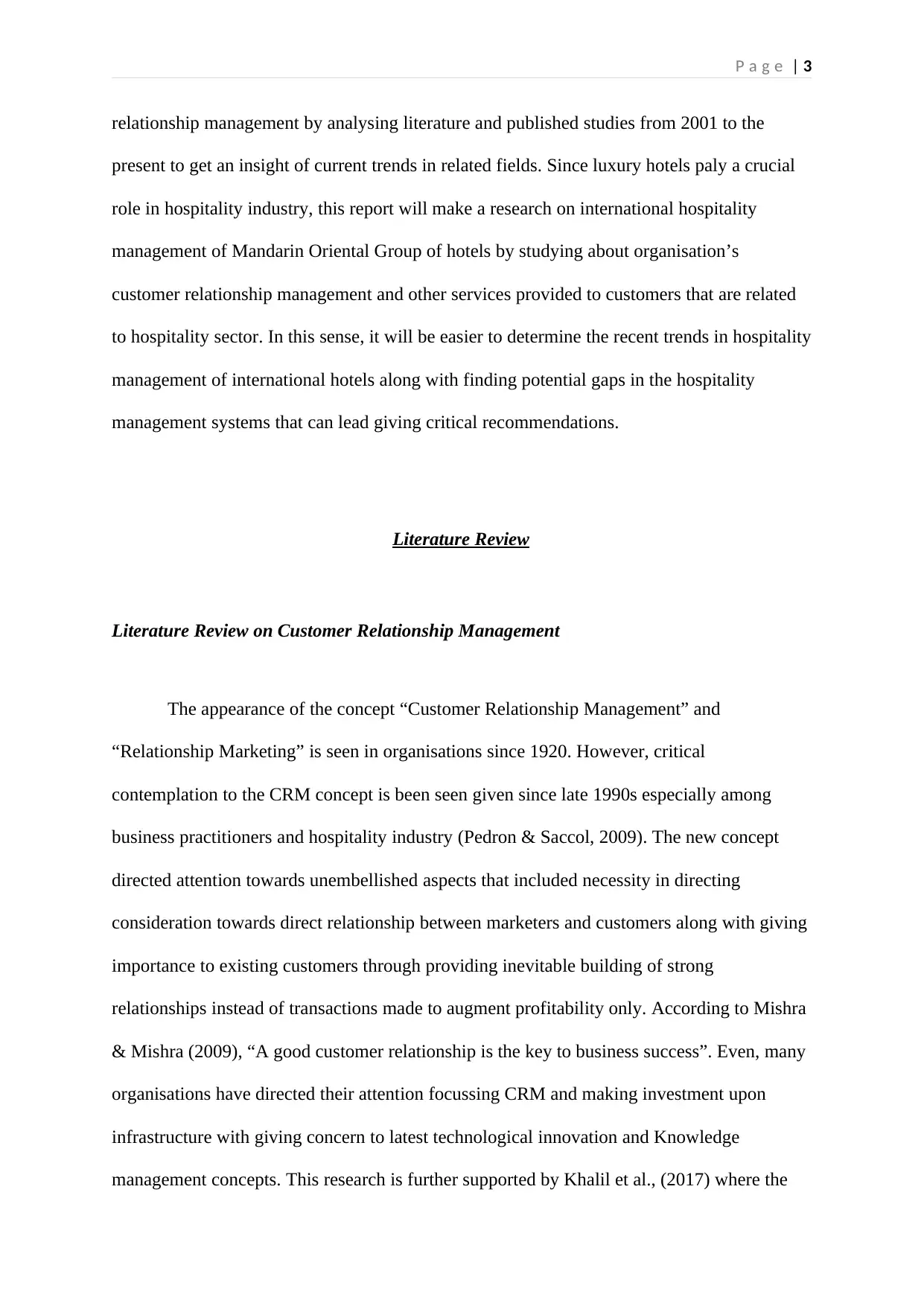
P a g e | 3
relationship management by analysing literature and published studies from 2001 to the
present to get an insight of current trends in related fields. Since luxury hotels paly a crucial
role in hospitality industry, this report will make a research on international hospitality
management of Mandarin Oriental Group of hotels by studying about organisation’s
customer relationship management and other services provided to customers that are related
to hospitality sector. In this sense, it will be easier to determine the recent trends in hospitality
management of international hotels along with finding potential gaps in the hospitality
management systems that can lead giving critical recommendations.
Literature Review
Literature Review on Customer Relationship Management
The appearance of the concept “Customer Relationship Management” and
“Relationship Marketing” is seen in organisations since 1920. However, critical
contemplation to the CRM concept is been seen given since late 1990s especially among
business practitioners and hospitality industry (Pedron & Saccol, 2009). The new concept
directed attention towards unembellished aspects that included necessity in directing
consideration towards direct relationship between marketers and customers along with giving
importance to existing customers through providing inevitable building of strong
relationships instead of transactions made to augment profitability only. According to Mishra
& Mishra (2009), “A good customer relationship is the key to business success”. Even, many
organisations have directed their attention focussing CRM and making investment upon
infrastructure with giving concern to latest technological innovation and Knowledge
management concepts. This research is further supported by Khalil et al., (2017) where the
relationship management by analysing literature and published studies from 2001 to the
present to get an insight of current trends in related fields. Since luxury hotels paly a crucial
role in hospitality industry, this report will make a research on international hospitality
management of Mandarin Oriental Group of hotels by studying about organisation’s
customer relationship management and other services provided to customers that are related
to hospitality sector. In this sense, it will be easier to determine the recent trends in hospitality
management of international hotels along with finding potential gaps in the hospitality
management systems that can lead giving critical recommendations.
Literature Review
Literature Review on Customer Relationship Management
The appearance of the concept “Customer Relationship Management” and
“Relationship Marketing” is seen in organisations since 1920. However, critical
contemplation to the CRM concept is been seen given since late 1990s especially among
business practitioners and hospitality industry (Pedron & Saccol, 2009). The new concept
directed attention towards unembellished aspects that included necessity in directing
consideration towards direct relationship between marketers and customers along with giving
importance to existing customers through providing inevitable building of strong
relationships instead of transactions made to augment profitability only. According to Mishra
& Mishra (2009), “A good customer relationship is the key to business success”. Even, many
organisations have directed their attention focussing CRM and making investment upon
infrastructure with giving concern to latest technological innovation and Knowledge
management concepts. This research is further supported by Khalil et al., (2017) where the
Paraphrase This Document
Need a fresh take? Get an instant paraphrase of this document with our AI Paraphraser

P a g e | 4
authors have coined the term CRM with correlation between administrative effectiveness and
customer service for improved development in marketing strategies.
CRM is been considered as one of the most dynamic strategies among millennials
where authors state that CRM concept is not new, rather due advancements in technologies
and current business developments it has gained practical significance ( Alipour &
Mohammadi, 2011). The base of CRM is relationship promotion which has objectives of
improving firm’s sustainable growth and profitability of customers by moving ahead of
product centric marketing strategies. In literature, it has been noted that CRM was invented
since customers varies in terms of purchase habits and preferences. If every customer
possessed similar attitude, CRM would have not been needed (Soliman, 2011). However, to
understand customer drivers and their profitability, firms get tailored by offering effective
product portfolio so that customers remains satisfied and connected (Khalil , et al., 2017).
Since today’s business world have become more competitive and saturated, more and more
companies are considering enabling of CRM practices especially the ones whose business
operations are spread across border nations. Soliman (2011) defined CRM as an
“organization carrying out a lot of information about the customer from various resources and
keeping it in order to divide the territories, analyse and reuse.” CRM is usually enterprise-
focussed function encompassing every department in business which means that in addition
to customer-oriented service, an effective CRM would also include product testing,
manufacturing, billing, marketing as well as human resource related services.
According to Alipour & Mohammadi (2011), CRM is about captivating and engaging
clients to increase businesses for which firms need to recognise the significance of achieving
insights of their valuable clients. To encourage profitable growth, organisations must focus
on customers preferences by designing and constantly modifying communication skills and
business processes to convey and build outstanding customer experiences. By giving
authors have coined the term CRM with correlation between administrative effectiveness and
customer service for improved development in marketing strategies.
CRM is been considered as one of the most dynamic strategies among millennials
where authors state that CRM concept is not new, rather due advancements in technologies
and current business developments it has gained practical significance ( Alipour &
Mohammadi, 2011). The base of CRM is relationship promotion which has objectives of
improving firm’s sustainable growth and profitability of customers by moving ahead of
product centric marketing strategies. In literature, it has been noted that CRM was invented
since customers varies in terms of purchase habits and preferences. If every customer
possessed similar attitude, CRM would have not been needed (Soliman, 2011). However, to
understand customer drivers and their profitability, firms get tailored by offering effective
product portfolio so that customers remains satisfied and connected (Khalil , et al., 2017).
Since today’s business world have become more competitive and saturated, more and more
companies are considering enabling of CRM practices especially the ones whose business
operations are spread across border nations. Soliman (2011) defined CRM as an
“organization carrying out a lot of information about the customer from various resources and
keeping it in order to divide the territories, analyse and reuse.” CRM is usually enterprise-
focussed function encompassing every department in business which means that in addition
to customer-oriented service, an effective CRM would also include product testing,
manufacturing, billing, marketing as well as human resource related services.
According to Alipour & Mohammadi (2011), CRM is about captivating and engaging
clients to increase businesses for which firms need to recognise the significance of achieving
insights of their valuable clients. To encourage profitable growth, organisations must focus
on customers preferences by designing and constantly modifying communication skills and
business processes to convey and build outstanding customer experiences. By giving

P a g e | 5
professional touch to every organisational level, loyalty within customers becomes visible
that acts as valuable assets for any firm ( Mishra & Mishra , 2009). It can also be said that
CRM is a combination of business process, individuals and technology which has been
designed to control and recognise organisation’s relations with customers by focussing upon
them through customer retention and relationship development. Nevertheless, the core
intention remains the same which is increase profits by obtaining equilibrium among client
contentment and corporate investments. However, Saeed, et al. (2010) argues that “most
researches concur with the finding that the relationship between satisfaction and loyalty is
neither linear nor simple”. Customer loyalty and satisfaction through interactions can
sometimes become difficult to be defined particularly when the situations become complex
and full of conflicts. The impact of customer loyalty can become complex which makes the
study of CRM address relationship issues also. Moreover, many organisations that
implements CRM often gets confused about what CRM actually is meant for and their
managers ends up struggling in finding out where CRM process can be started from. Pedron
& Saccol (2009) further supports the above statement by pointing out uncertainties in CRM
practices that may occur due to failure in understanding the implication of managing
practices and true meaning of relationship management.
In literature, relationship marketing is defined as an approach that has potentiality to
beat service intangibility along with making service-oriented business more suitable for
gaining service related creditability. By forming association with customers, the firm itself
gains customer loyalty, but personal relationships add further to it by accumulating larger
commitments ( Gupta & Sahu, 2012). There are various components through which CRM can
be organised in organisations and are clustered together depending to the type of situation
demanded to manage customer relationships (Saeed, et al., 2010). Few of them have been
professional touch to every organisational level, loyalty within customers becomes visible
that acts as valuable assets for any firm ( Mishra & Mishra , 2009). It can also be said that
CRM is a combination of business process, individuals and technology which has been
designed to control and recognise organisation’s relations with customers by focussing upon
them through customer retention and relationship development. Nevertheless, the core
intention remains the same which is increase profits by obtaining equilibrium among client
contentment and corporate investments. However, Saeed, et al. (2010) argues that “most
researches concur with the finding that the relationship between satisfaction and loyalty is
neither linear nor simple”. Customer loyalty and satisfaction through interactions can
sometimes become difficult to be defined particularly when the situations become complex
and full of conflicts. The impact of customer loyalty can become complex which makes the
study of CRM address relationship issues also. Moreover, many organisations that
implements CRM often gets confused about what CRM actually is meant for and their
managers ends up struggling in finding out where CRM process can be started from. Pedron
& Saccol (2009) further supports the above statement by pointing out uncertainties in CRM
practices that may occur due to failure in understanding the implication of managing
practices and true meaning of relationship management.
In literature, relationship marketing is defined as an approach that has potentiality to
beat service intangibility along with making service-oriented business more suitable for
gaining service related creditability. By forming association with customers, the firm itself
gains customer loyalty, but personal relationships add further to it by accumulating larger
commitments ( Gupta & Sahu, 2012). There are various components through which CRM can
be organised in organisations and are clustered together depending to the type of situation
demanded to manage customer relationships (Saeed, et al., 2010). Few of them have been
⊘ This is a preview!⊘
Do you want full access?
Subscribe today to unlock all pages.

Trusted by 1+ million students worldwide
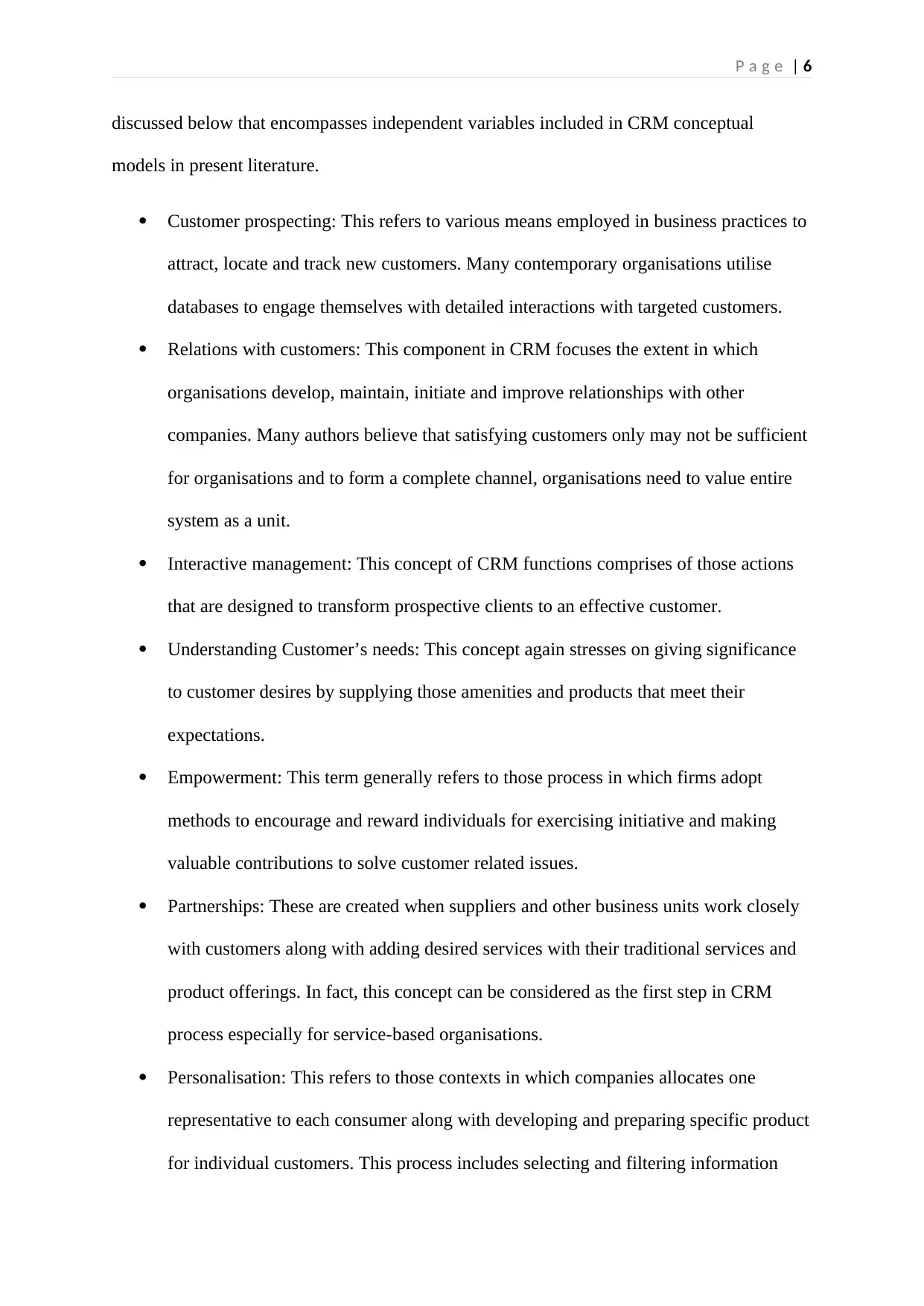
P a g e | 6
discussed below that encompasses independent variables included in CRM conceptual
models in present literature.
Customer prospecting: This refers to various means employed in business practices to
attract, locate and track new customers. Many contemporary organisations utilise
databases to engage themselves with detailed interactions with targeted customers.
Relations with customers: This component in CRM focuses the extent in which
organisations develop, maintain, initiate and improve relationships with other
companies. Many authors believe that satisfying customers only may not be sufficient
for organisations and to form a complete channel, organisations need to value entire
system as a unit.
Interactive management: This concept of CRM functions comprises of those actions
that are designed to transform prospective clients to an effective customer.
Understanding Customer’s needs: This concept again stresses on giving significance
to customer desires by supplying those amenities and products that meet their
expectations.
Empowerment: This term generally refers to those process in which firms adopt
methods to encourage and reward individuals for exercising initiative and making
valuable contributions to solve customer related issues.
Partnerships: These are created when suppliers and other business units work closely
with customers along with adding desired services with their traditional services and
product offerings. In fact, this concept can be considered as the first step in CRM
process especially for service-based organisations.
Personalisation: This refers to those contexts in which companies allocates one
representative to each consumer along with developing and preparing specific product
for individual customers. This process includes selecting and filtering information
discussed below that encompasses independent variables included in CRM conceptual
models in present literature.
Customer prospecting: This refers to various means employed in business practices to
attract, locate and track new customers. Many contemporary organisations utilise
databases to engage themselves with detailed interactions with targeted customers.
Relations with customers: This component in CRM focuses the extent in which
organisations develop, maintain, initiate and improve relationships with other
companies. Many authors believe that satisfying customers only may not be sufficient
for organisations and to form a complete channel, organisations need to value entire
system as a unit.
Interactive management: This concept of CRM functions comprises of those actions
that are designed to transform prospective clients to an effective customer.
Understanding Customer’s needs: This concept again stresses on giving significance
to customer desires by supplying those amenities and products that meet their
expectations.
Empowerment: This term generally refers to those process in which firms adopt
methods to encourage and reward individuals for exercising initiative and making
valuable contributions to solve customer related issues.
Partnerships: These are created when suppliers and other business units work closely
with customers along with adding desired services with their traditional services and
product offerings. In fact, this concept can be considered as the first step in CRM
process especially for service-based organisations.
Personalisation: This refers to those contexts in which companies allocates one
representative to each consumer along with developing and preparing specific product
for individual customers. This process includes selecting and filtering information
Paraphrase This Document
Need a fresh take? Get an instant paraphrase of this document with our AI Paraphraser

P a g e | 7
thorough reading customer profile along with distributing customised mails to gain
customer attention.
Loyalty: Loyalty involves sustaining a relationship along with building them
effectively that can lead to repeated purchase of service or product in a given time
period. A loyal customer will always allow companies to devote their products and
offerings for which they choose to stay connected with the company (Lawson &
Limayem, 2004).
Literature Review on Hospitality Management
Tourism can be defined as an act in which people travel from one place to the other
for leisurely or business purpose (Morrison & Gorman, 2008). According to WTO (World
Tourism Organisation), “tourism invites visiting to places other than one’s domicile for
pleasure and recreation from where one does not receive monetary benefits” (Andrews,
2007). In tourism industry, hospitality plays a significant role that includes hotel and
restaurant establishments. It can be said that hospitality industry act as a broader service
industry in which people create services to provide customers with satisfactory experience
along with generating revenues for the firms. According to Morrison & Gorman (2008),
Hospitality is a product of tourism that can be defined by relationships between service
providers and the guests. Services can be further categorised under various offerings that
includes customers psychological and physiological needs. Borralha, et al. (2016) says that
hospitality is one of the world’s largest industry that incorporates the concept of cultural,
commercial, private and social context. According to the authors, the chief feature of
hospitality industry is formation of emotional bonding with customers. For this, hotels need
thorough reading customer profile along with distributing customised mails to gain
customer attention.
Loyalty: Loyalty involves sustaining a relationship along with building them
effectively that can lead to repeated purchase of service or product in a given time
period. A loyal customer will always allow companies to devote their products and
offerings for which they choose to stay connected with the company (Lawson &
Limayem, 2004).
Literature Review on Hospitality Management
Tourism can be defined as an act in which people travel from one place to the other
for leisurely or business purpose (Morrison & Gorman, 2008). According to WTO (World
Tourism Organisation), “tourism invites visiting to places other than one’s domicile for
pleasure and recreation from where one does not receive monetary benefits” (Andrews,
2007). In tourism industry, hospitality plays a significant role that includes hotel and
restaurant establishments. It can be said that hospitality industry act as a broader service
industry in which people create services to provide customers with satisfactory experience
along with generating revenues for the firms. According to Morrison & Gorman (2008),
Hospitality is a product of tourism that can be defined by relationships between service
providers and the guests. Services can be further categorised under various offerings that
includes customers psychological and physiological needs. Borralha, et al. (2016) says that
hospitality is one of the world’s largest industry that incorporates the concept of cultural,
commercial, private and social context. According to the authors, the chief feature of
hospitality industry is formation of emotional bonding with customers. For this, hotels need
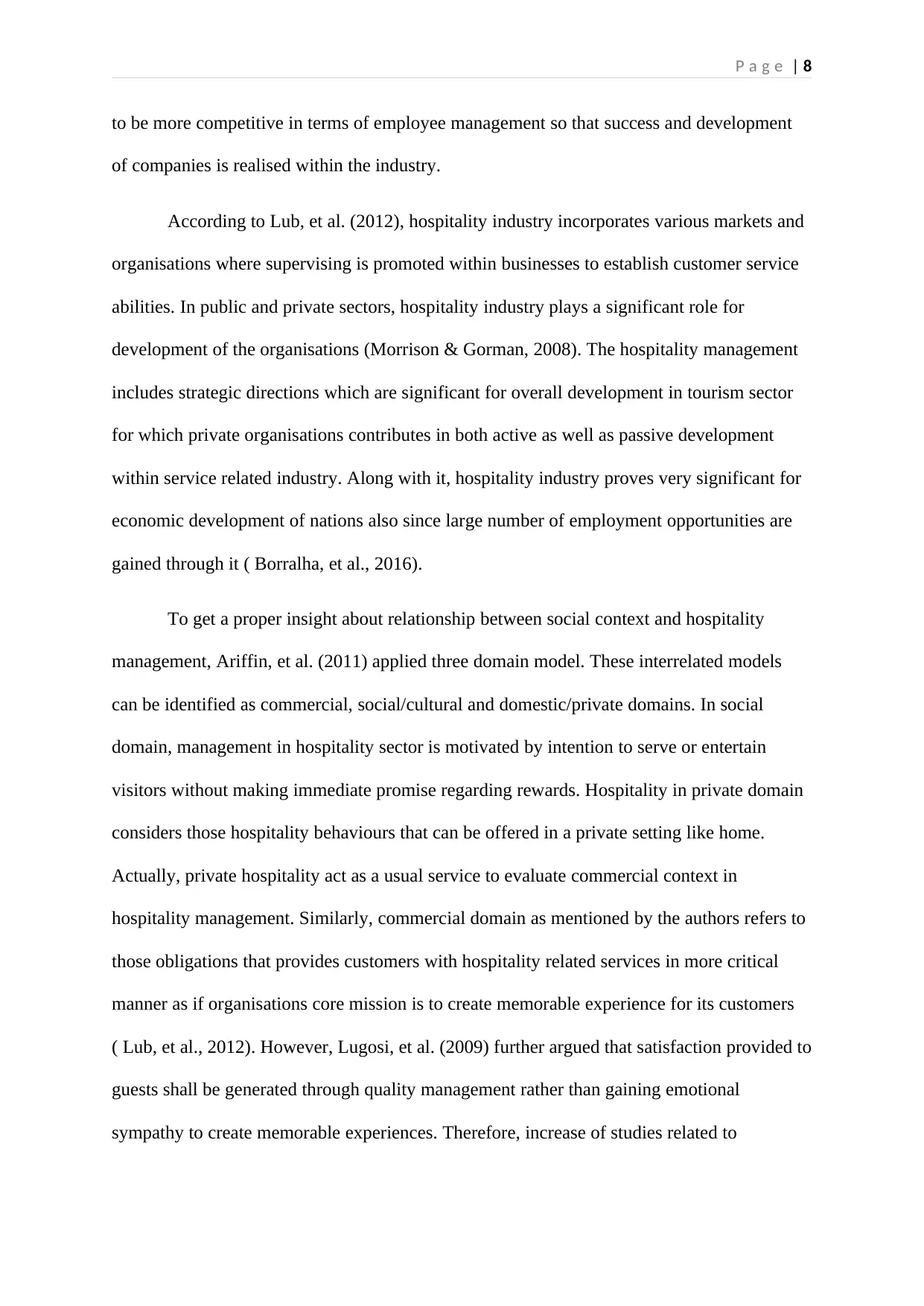
P a g e | 8
to be more competitive in terms of employee management so that success and development
of companies is realised within the industry.
According to Lub, et al. (2012), hospitality industry incorporates various markets and
organisations where supervising is promoted within businesses to establish customer service
abilities. In public and private sectors, hospitality industry plays a significant role for
development of the organisations (Morrison & Gorman, 2008). The hospitality management
includes strategic directions which are significant for overall development in tourism sector
for which private organisations contributes in both active as well as passive development
within service related industry. Along with it, hospitality industry proves very significant for
economic development of nations also since large number of employment opportunities are
gained through it ( Borralha, et al., 2016).
To get a proper insight about relationship between social context and hospitality
management, Ariffin, et al. (2011) applied three domain model. These interrelated models
can be identified as commercial, social/cultural and domestic/private domains. In social
domain, management in hospitality sector is motivated by intention to serve or entertain
visitors without making immediate promise regarding rewards. Hospitality in private domain
considers those hospitality behaviours that can be offered in a private setting like home.
Actually, private hospitality act as a usual service to evaluate commercial context in
hospitality management. Similarly, commercial domain as mentioned by the authors refers to
those obligations that provides customers with hospitality related services in more critical
manner as if organisations core mission is to create memorable experience for its customers
( Lub, et al., 2012). However, Lugosi, et al. (2009) further argued that satisfaction provided to
guests shall be generated through quality management rather than gaining emotional
sympathy to create memorable experiences. Therefore, increase of studies related to
to be more competitive in terms of employee management so that success and development
of companies is realised within the industry.
According to Lub, et al. (2012), hospitality industry incorporates various markets and
organisations where supervising is promoted within businesses to establish customer service
abilities. In public and private sectors, hospitality industry plays a significant role for
development of the organisations (Morrison & Gorman, 2008). The hospitality management
includes strategic directions which are significant for overall development in tourism sector
for which private organisations contributes in both active as well as passive development
within service related industry. Along with it, hospitality industry proves very significant for
economic development of nations also since large number of employment opportunities are
gained through it ( Borralha, et al., 2016).
To get a proper insight about relationship between social context and hospitality
management, Ariffin, et al. (2011) applied three domain model. These interrelated models
can be identified as commercial, social/cultural and domestic/private domains. In social
domain, management in hospitality sector is motivated by intention to serve or entertain
visitors without making immediate promise regarding rewards. Hospitality in private domain
considers those hospitality behaviours that can be offered in a private setting like home.
Actually, private hospitality act as a usual service to evaluate commercial context in
hospitality management. Similarly, commercial domain as mentioned by the authors refers to
those obligations that provides customers with hospitality related services in more critical
manner as if organisations core mission is to create memorable experience for its customers
( Lub, et al., 2012). However, Lugosi, et al. (2009) further argued that satisfaction provided to
guests shall be generated through quality management rather than gaining emotional
sympathy to create memorable experiences. Therefore, increase of studies related to
⊘ This is a preview!⊘
Do you want full access?
Subscribe today to unlock all pages.

Trusted by 1+ million students worldwide
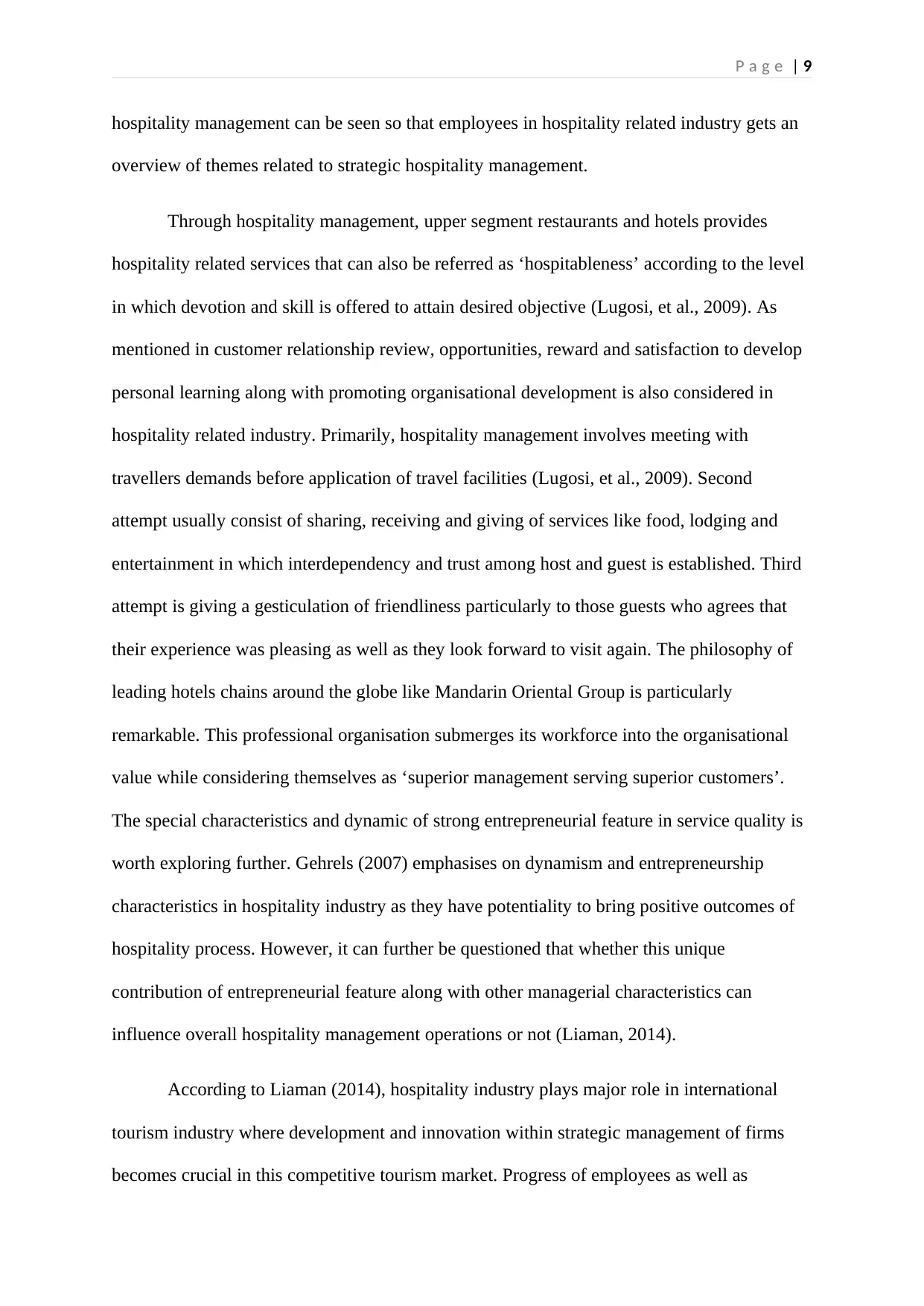
P a g e | 9
hospitality management can be seen so that employees in hospitality related industry gets an
overview of themes related to strategic hospitality management.
Through hospitality management, upper segment restaurants and hotels provides
hospitality related services that can also be referred as ‘hospitableness’ according to the level
in which devotion and skill is offered to attain desired objective (Lugosi, et al., 2009). As
mentioned in customer relationship review, opportunities, reward and satisfaction to develop
personal learning along with promoting organisational development is also considered in
hospitality related industry. Primarily, hospitality management involves meeting with
travellers demands before application of travel facilities (Lugosi, et al., 2009). Second
attempt usually consist of sharing, receiving and giving of services like food, lodging and
entertainment in which interdependency and trust among host and guest is established. Third
attempt is giving a gesticulation of friendliness particularly to those guests who agrees that
their experience was pleasing as well as they look forward to visit again. The philosophy of
leading hotels chains around the globe like Mandarin Oriental Group is particularly
remarkable. This professional organisation submerges its workforce into the organisational
value while considering themselves as ‘superior management serving superior customers’.
The special characteristics and dynamic of strong entrepreneurial feature in service quality is
worth exploring further. Gehrels (2007) emphasises on dynamism and entrepreneurship
characteristics in hospitality industry as they have potentiality to bring positive outcomes of
hospitality process. However, it can further be questioned that whether this unique
contribution of entrepreneurial feature along with other managerial characteristics can
influence overall hospitality management operations or not (Liaman, 2014).
According to Liaman (2014), hospitality industry plays major role in international
tourism industry where development and innovation within strategic management of firms
becomes crucial in this competitive tourism market. Progress of employees as well as
hospitality management can be seen so that employees in hospitality related industry gets an
overview of themes related to strategic hospitality management.
Through hospitality management, upper segment restaurants and hotels provides
hospitality related services that can also be referred as ‘hospitableness’ according to the level
in which devotion and skill is offered to attain desired objective (Lugosi, et al., 2009). As
mentioned in customer relationship review, opportunities, reward and satisfaction to develop
personal learning along with promoting organisational development is also considered in
hospitality related industry. Primarily, hospitality management involves meeting with
travellers demands before application of travel facilities (Lugosi, et al., 2009). Second
attempt usually consist of sharing, receiving and giving of services like food, lodging and
entertainment in which interdependency and trust among host and guest is established. Third
attempt is giving a gesticulation of friendliness particularly to those guests who agrees that
their experience was pleasing as well as they look forward to visit again. The philosophy of
leading hotels chains around the globe like Mandarin Oriental Group is particularly
remarkable. This professional organisation submerges its workforce into the organisational
value while considering themselves as ‘superior management serving superior customers’.
The special characteristics and dynamic of strong entrepreneurial feature in service quality is
worth exploring further. Gehrels (2007) emphasises on dynamism and entrepreneurship
characteristics in hospitality industry as they have potentiality to bring positive outcomes of
hospitality process. However, it can further be questioned that whether this unique
contribution of entrepreneurial feature along with other managerial characteristics can
influence overall hospitality management operations or not (Liaman, 2014).
According to Liaman (2014), hospitality industry plays major role in international
tourism industry where development and innovation within strategic management of firms
becomes crucial in this competitive tourism market. Progress of employees as well as
Paraphrase This Document
Need a fresh take? Get an instant paraphrase of this document with our AI Paraphraser
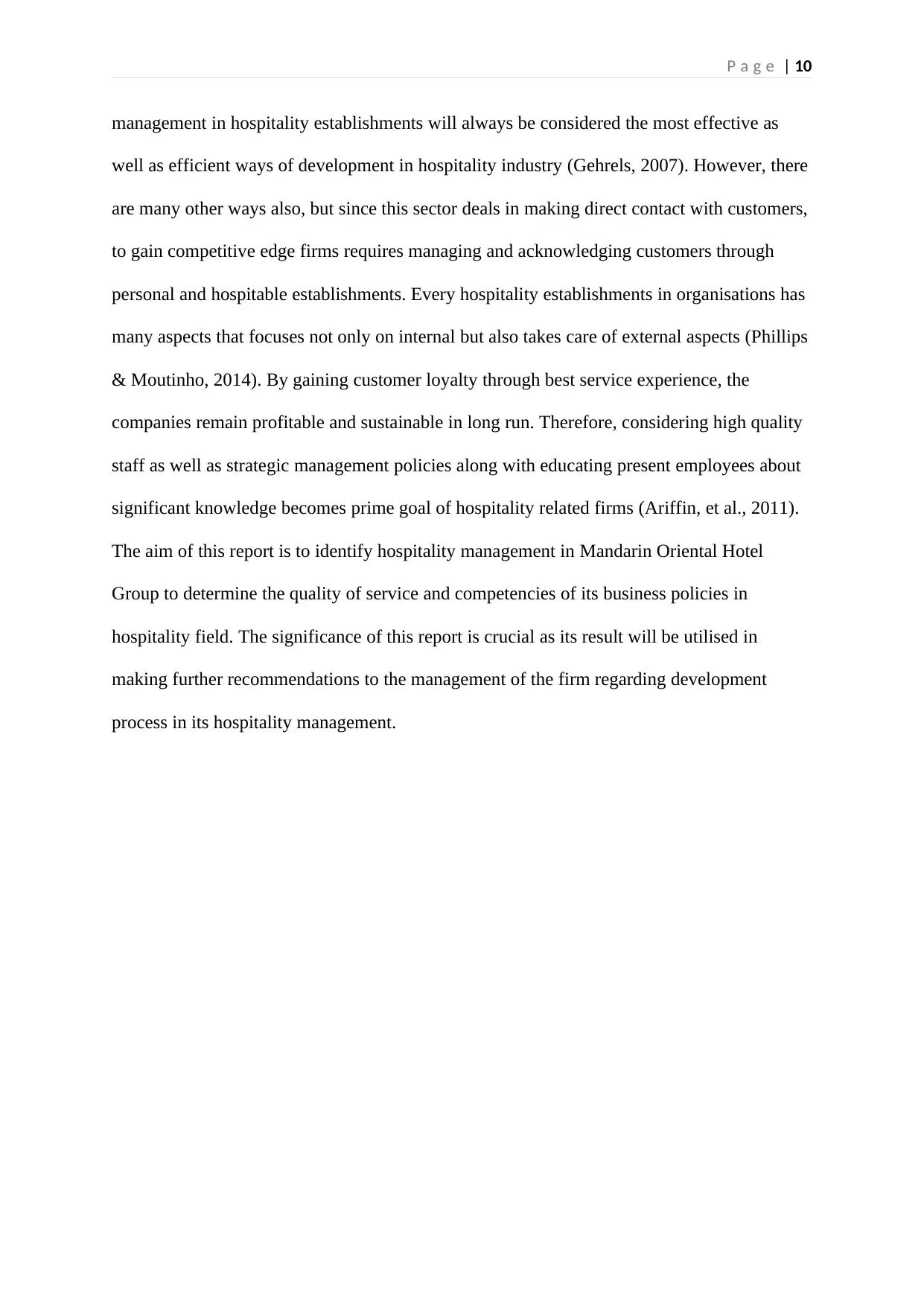
P a g e | 10
management in hospitality establishments will always be considered the most effective as
well as efficient ways of development in hospitality industry (Gehrels, 2007). However, there
are many other ways also, but since this sector deals in making direct contact with customers,
to gain competitive edge firms requires managing and acknowledging customers through
personal and hospitable establishments. Every hospitality establishments in organisations has
many aspects that focuses not only on internal but also takes care of external aspects (Phillips
& Moutinho, 2014). By gaining customer loyalty through best service experience, the
companies remain profitable and sustainable in long run. Therefore, considering high quality
staff as well as strategic management policies along with educating present employees about
significant knowledge becomes prime goal of hospitality related firms (Ariffin, et al., 2011).
The aim of this report is to identify hospitality management in Mandarin Oriental Hotel
Group to determine the quality of service and competencies of its business policies in
hospitality field. The significance of this report is crucial as its result will be utilised in
making further recommendations to the management of the firm regarding development
process in its hospitality management.
management in hospitality establishments will always be considered the most effective as
well as efficient ways of development in hospitality industry (Gehrels, 2007). However, there
are many other ways also, but since this sector deals in making direct contact with customers,
to gain competitive edge firms requires managing and acknowledging customers through
personal and hospitable establishments. Every hospitality establishments in organisations has
many aspects that focuses not only on internal but also takes care of external aspects (Phillips
& Moutinho, 2014). By gaining customer loyalty through best service experience, the
companies remain profitable and sustainable in long run. Therefore, considering high quality
staff as well as strategic management policies along with educating present employees about
significant knowledge becomes prime goal of hospitality related firms (Ariffin, et al., 2011).
The aim of this report is to identify hospitality management in Mandarin Oriental Hotel
Group to determine the quality of service and competencies of its business policies in
hospitality field. The significance of this report is crucial as its result will be utilised in
making further recommendations to the management of the firm regarding development
process in its hospitality management.
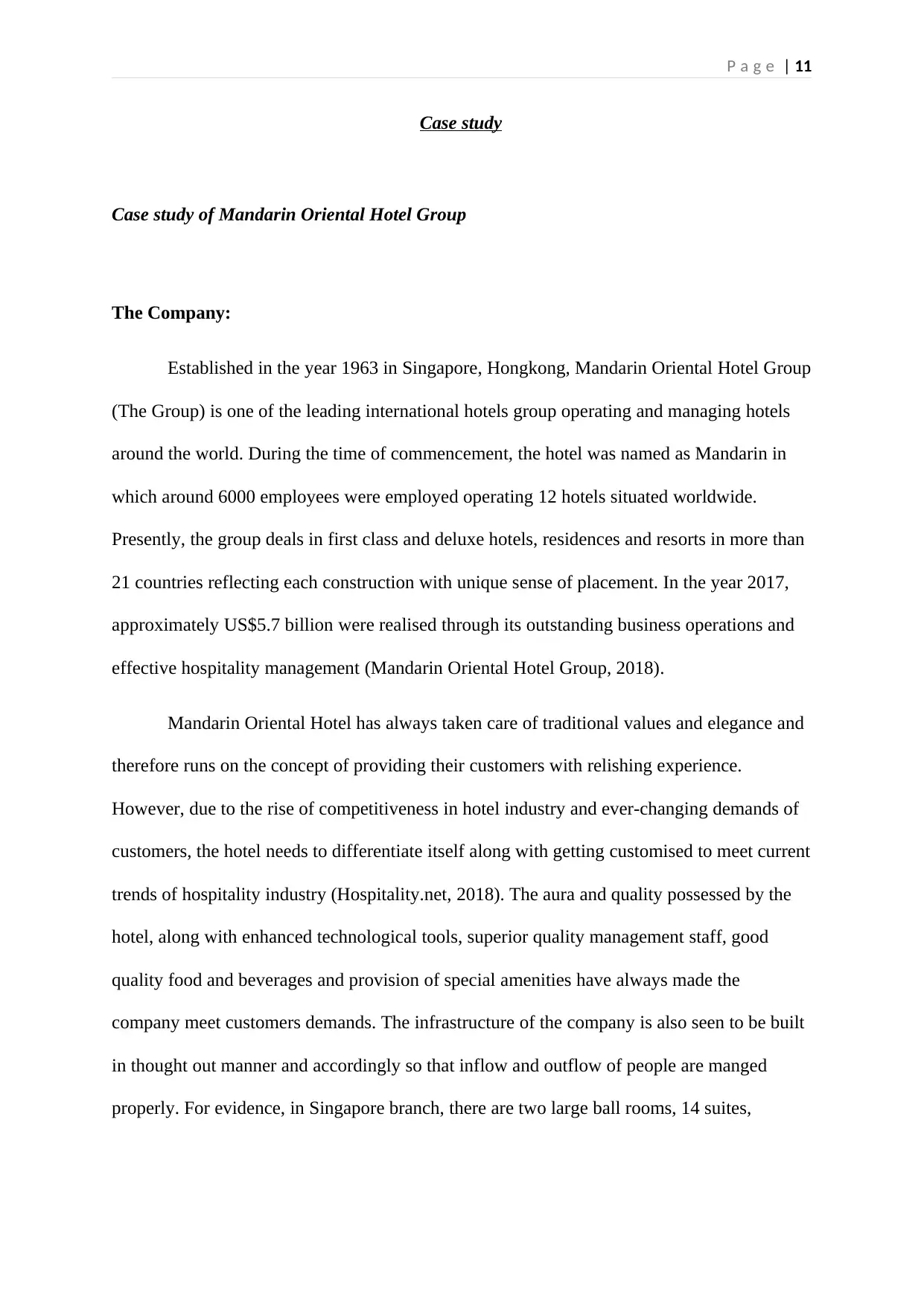
P a g e | 11
Case study
Case study of Mandarin Oriental Hotel Group
The Company:
Established in the year 1963 in Singapore, Hongkong, Mandarin Oriental Hotel Group
(The Group) is one of the leading international hotels group operating and managing hotels
around the world. During the time of commencement, the hotel was named as Mandarin in
which around 6000 employees were employed operating 12 hotels situated worldwide.
Presently, the group deals in first class and deluxe hotels, residences and resorts in more than
21 countries reflecting each construction with unique sense of placement. In the year 2017,
approximately US$5.7 billion were realised through its outstanding business operations and
effective hospitality management (Mandarin Oriental Hotel Group, 2018).
Mandarin Oriental Hotel has always taken care of traditional values and elegance and
therefore runs on the concept of providing their customers with relishing experience.
However, due to the rise of competitiveness in hotel industry and ever-changing demands of
customers, the hotel needs to differentiate itself along with getting customised to meet current
trends of hospitality industry (Hospitality.net, 2018). The aura and quality possessed by the
hotel, along with enhanced technological tools, superior quality management staff, good
quality food and beverages and provision of special amenities have always made the
company meet customers demands. The infrastructure of the company is also seen to be built
in thought out manner and accordingly so that inflow and outflow of people are manged
properly. For evidence, in Singapore branch, there are two large ball rooms, 14 suites,
Case study
Case study of Mandarin Oriental Hotel Group
The Company:
Established in the year 1963 in Singapore, Hongkong, Mandarin Oriental Hotel Group
(The Group) is one of the leading international hotels group operating and managing hotels
around the world. During the time of commencement, the hotel was named as Mandarin in
which around 6000 employees were employed operating 12 hotels situated worldwide.
Presently, the group deals in first class and deluxe hotels, residences and resorts in more than
21 countries reflecting each construction with unique sense of placement. In the year 2017,
approximately US$5.7 billion were realised through its outstanding business operations and
effective hospitality management (Mandarin Oriental Hotel Group, 2018).
Mandarin Oriental Hotel has always taken care of traditional values and elegance and
therefore runs on the concept of providing their customers with relishing experience.
However, due to the rise of competitiveness in hotel industry and ever-changing demands of
customers, the hotel needs to differentiate itself along with getting customised to meet current
trends of hospitality industry (Hospitality.net, 2018). The aura and quality possessed by the
hotel, along with enhanced technological tools, superior quality management staff, good
quality food and beverages and provision of special amenities have always made the
company meet customers demands. The infrastructure of the company is also seen to be built
in thought out manner and accordingly so that inflow and outflow of people are manged
properly. For evidence, in Singapore branch, there are two large ball rooms, 14 suites,
⊘ This is a preview!⊘
Do you want full access?
Subscribe today to unlock all pages.

Trusted by 1+ million students worldwide
1 out of 22
Related Documents
Your All-in-One AI-Powered Toolkit for Academic Success.
+13062052269
info@desklib.com
Available 24*7 on WhatsApp / Email
![[object Object]](/_next/static/media/star-bottom.7253800d.svg)
Unlock your academic potential
Copyright © 2020–2025 A2Z Services. All Rights Reserved. Developed and managed by ZUCOL.





